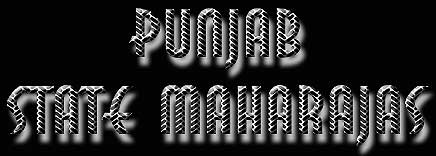

Name
& Foundation of Kapurthala
It is said that Kapurthala was founded in
the 11th Century during the period of Mahmood Gaznvi. This town was established
by Rana Kapoor of Rajput Gharana, of Jaisalmer. On his name, the place has got
its name- Kapurthala.
Almost two centuries ago, When the notorious Ahmed Shah
descended upon India for the fifth time in his rapacious career and defeated the
Mahrattas from the Punjab. The Sikh community re-established and strengthened
their position after about a generation of historical oblivion. When the Sikhs
slew Zain Khan in December 1763, Sikh independence became an established fact.
Ahmed Shah's subsequent raids of 1764 and 1767 achieved nothing against the Sikhs.
One of themost resplendent figure in Sikh history after the ten Gurus, barring
the great Maharaja Ranjit Singh, was Sardar Jassa Singh Ahluwalia.
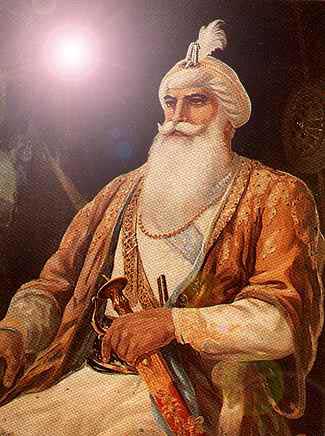
Sardar Jassa Singh Ahluwalia
The story of Kapurthala is inextricably inter-woven with the life and struggles of Jassa Singh.

It
was Sardar Jassa Singh Ahluwalia(1718-1783) who evicted Ibrahim Khan, a usurper
after the death of Mughal Governor Adina Beg, from Kapurthala. Jassa Singh selected
Kapurthala as his capital.
He was successor of Nawab Kapur Singh, who was
given the honour of Nawab by the Sikh Confederation in 1754 AD. He was a brave
man and held at very high esteem by his people.
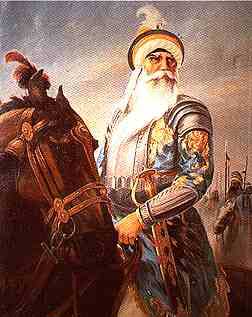
Nawab Kapur Singh
The word Ahluwalia comes from a name of Ahlu
village that was raised by Sardar Sadhu Singh ( Sado) of Kapurthala and is now
in Lahore district of Pakistan.
As Jassa Singh Ahluwalia had no issue, his
second cousin S.Bhag Singh was made ruler. After his death in 1803 his son Fateh
Singh became the ruler. He had close friendship with Maharaja Ranjit Singh.
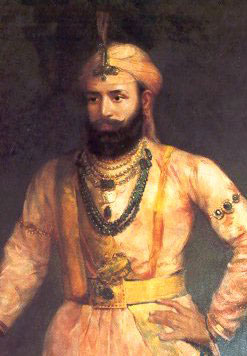
1801 - 1837 Raja Fateh Singh Ahluwalia, Raja of Kapurthala. b. at Kapurthala Fort, 1784
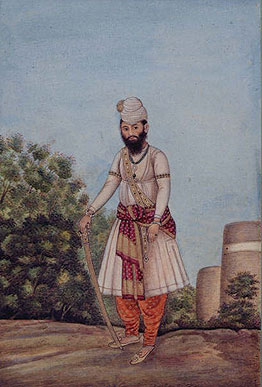
Raja Fateh Singh
He was the first king of Punjab to enter into a treaty with the East India Company in 1806. On his death in 1836 his son Raja Nihal Singh became the king. S. Jassa Singh had acquired lands both to the North and South of Sutlej River. But the treaty of 1805 stipulated that the Sutlej should form the boundary between East India Company's territory and Raja Ranjit Singh's emergent kingdom. Raja Fateh Singh served as an able Lieutenant in Ranjit Singh's campaigns but because of some misunderstanding in 1825, he left the north of Sutlej and lived a lonely life thereafter. His successor Raja Nihal Singh who took the reign in 1836, also remained neutral but his soldiers inevitably backed Sikhs and as a result Southern portion of Kapurthala was annexed by the British. After that all the kings of Kapurthala tried to convert it into a model city-state rather than concentrating on the British-India war.
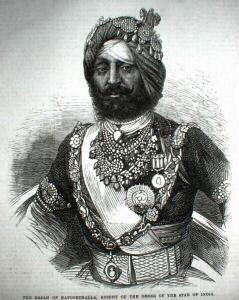
In
1852 S Nihal Singh died and his son Raja-i-Rajjan
Raja Randhir Singh (above) took over. During the 1857 war of Independence
he was awarded a title of Grand Commander of the order of the star of India (GCSI)
by the British for his support. His son Maharaja Kharak Singh ruled the state
from 1870 to 1877.
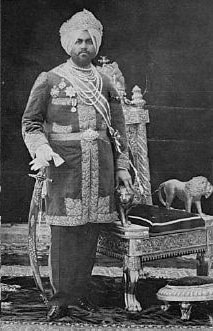
Maharaja Jagatjit Singh (1872-1948)
Maharaja Kharak Singh 's son Tikka Jagatjit Singh (1872-1948) became the ruler when he was barely five years old. During his minority the state was administered by an officer of Punjab Commission, assisted by a council composed of the Principal officials of the state. The Maharaja had the rare honour of occupying the Gaddi for 67 years and actually ruling the State for more than 55 years ( till 1948)
Life
Sketch of Maharaja Jagatjit Singh
The young Maharaja was very
carefully brought up and received liberal education under the guardianship of
able and carefully selected tutors. At an early age he showed a singular linguistic
aptitude and acquired an intimate knowledge of English and French, both of which
he speaks most fluently besides learning Sanskrit, Hindi, Persian, Urdu and Gurmukhi.
During his minority the State was administered by a succession of brilliant British
Civilians, many of who became, in due course, Lieut-Governers. Among the most
prominent of them were Sir Lepel Griffin, Sir Mackworth Colonel Massy. These superintendents
who were ably assisted by a Council of trusted State officials introduced various
useful reforms, which were conducive to the efficiency of the State administration
and the general welfare of the people.
The Maharaja took great interest in
raising buildings, which included the main Palace, The Royal Courts or Court of
Justice, The Grand Moorish Mosque, The Gurudwara at Kapurthala and at Sultanpur
Lodhi (Gurudwara Ber Sahib). The Maharaja assumed government office state at the
eighteen years age on 24th November 1890. The Maharaja had the rare honour of
occupying the Gaddi for 67 years and actually ruling the State for more than 55
years (till 1948).
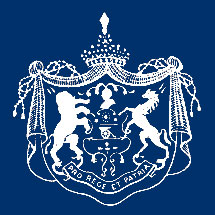
The Kapurthala Arms

The Jagatjit Palace
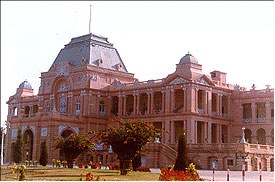
Palace
He was one the most widely traveled king of his time. He had been to all over Europe, North, Central and South America, Egypt, China, Japan, Siam, Java and the Straits settlement.
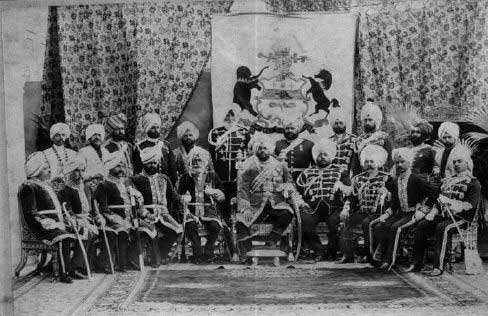
Maharaja Jagatjit Singh with his courtiers
The Maharaja had 13 guns Honours permanently and of 15 as a personal distinction. His title was 'His Highness Kings of Kings Brig. Maharaja Jagatjit Singh, G.C.S.I., G.C.I.E., G.B.E.' He represented India in the League of Nations in Geneva in 1926,1927 and 1929. He was also a member of plenary session of second round Table Conference in London in 1931. The Maharaja stood fifth in order of precedence among the ruling chiefs of Punjab. It is extremely rare if not altogether impossible to find an Indian Ruler occupying the Gaddi of his ancestors for a long period of sixty-seven years. Very few among the princely order of India had been favoured by fortune to actually rule their States for over fifty-four years like His Highness Maharaja Jagatjit Singh of Kapurthala.
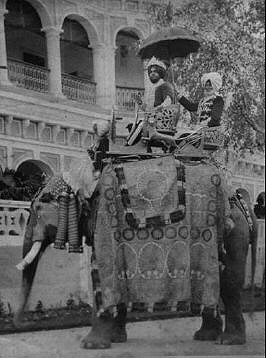
Maharaja Jagatjit Singh on an elephant
Anyone who had the privilege
of knowing His Highness intimately will recognize in him the most charming of
hosts possessing a sense of quiet humour which rendered him inimitable as a raconteur.
As a great traveler he had widened the circle of his friends and acquaintances
in both the hemispheres, but it was as a great gentleman that he had, with his
extraordinary savior-faire, won universal esteem.
Exactly at the age of eighteen
on 24th November, 1890 His Highness assumed the government of his State, the formal
ceremony of investiture being performed by Sir James Lyall, the then Lieutenant
Governor of the Punjab. Scenes of befitting splendour, the whole state being enfete,
marked the occasion.
The keynote of His Highness' policy had always been wholehearted
and thorough co-operation with the British Government, practical sympathy and
toleration with all classes of his subjects and a passion for progress in every
branch of the administration. He had all along taken the keenest personal interest
in the education of his subjects, and in matters relating to the health and sanitation
of the towns in the State. It is entirely due to his initiative that Kapurthala
has always been considered as one of the best-administered and progressive States
in India. Modern Kapurthala is in fact the creation of His Highness' foresight,
broad-mindedness and sagacity.
The successive Viceroys had suitably recognized
his Highness's achievements as a progressive Ruler, and he has been the recipient
of the highest titles and honours from His Majesty the King Emperor. King George
V at te Delhi Coronation Durbar conferred the hereditary title of Maharaja and
the G.C.S.I., upon him in 1911. To these were added the G.C.I.E., at the termination
of the Great War and G.B.E., on the occasion of his Golden Jubilee in 1927.
In
1918 in recognition of War services his Salute was raised from eleven to thirteen
guns permanently and to fifteen as a personal distinction. As a remitted altogether
the annual tribute of Rs. 1,31,000, which formerly the State paid in lieu of Military,
services. At the recommendation of Field Marshal Lord Birdwood, His Highness was
made an Honorary Colonel of the 45th(Rattreys' Sikhs) in the Indian Army, and
was promoted to be a Brigadier early in 1943.
As an earnest of the great popularity
and the unique position, which he commands in foreign countries the French Republic,
conferred upon him the Grand Cross of the Legion d'Honneur in 1924, and he had
received the highest decorations from Italy, Spain and several other European,
Asiatic and South American countries.
His Highness represented India on the
League of Nations at Geneva in 1926,1927 and 1929 and was selected to be a member
of the second plenary session of the Round Table Conference in London in 1931.
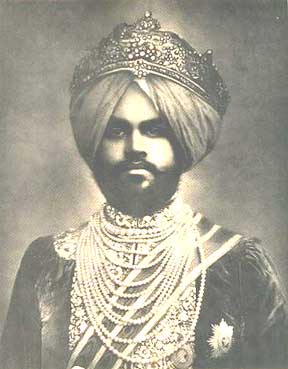
Maharaja Jagatjit Singh
His Highness had travelled far and wide over
the four continents, and had been twice round the world. He had been all over
Europe, North, Central and South America, Egypt, China, Japan, Siam, Java and
the Straits Settlements. The first of his foreign visits was undertaken in 1893
when His Highness had the honour to being invited as a guest of Queen Victoria
on the marriage of his Imperial Majesty King George V then Duke of York. The Maharaja
took part in Queen Victoria's Diamond Jubilee celebration when the queen herself
with the K.C.S.I. in London invested him. During his various visits to England
His Highness had always been cordially received by the British sovereigns, having
stayed at the Windsor castle as a guest of Queen Victoria three times, and also
at the Balmoral Castle in 1900 before Her Majesty Queen Mary favored the maharaja
with particular kindness and consideration throughout their region and invited
him several times to private luncheons at the Buckingham Palace. He enjoyed the
unique privilege of being present at the historic peace conference at Versailles
in 1919 after the last great war. These tours apart from broadening his own mental
outlook had been of practical value to the state in enabling His Highness to infuse
a progressive spirit into his administration.
Amongst the European Sovereigns
with whom the Maharaja claimed the privilege of personal acquaintance might be
mentioned Czar Nicholas of Russia; Emperor Francis Joseph of Austria, Hungary;
Emperor William 11 of Germany; King Humbert and king Victor Emanuel of Italy;
King Leopold, King Albert and King Leopold 11 of Belgium; King Alfonso of Spain
(a very intimate friend); King Gustav of Sweden and King Hakon of Norway. He had
also known every president of the French Republic from M. Sadi Carnot in 1893
to the last president, M. Lebrun, and presidents Wilson and Roosevelt of the United
States of America. During his three visits to Japan, he was first received by
Emperor Mutsuhito and on two occasions by the present Emperor.
The impress
of his charming personality and cultivated taste was apparent, particularly in
the capital of the State, which had been embellished with handsome palaces and
public buildings. In many ways Kapurthala had benefited from the Maharaja's application
of ideas gained as a frequent and observant traveller.
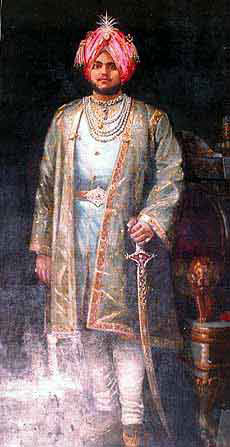
Family
of Maharaja Jagatjit Singh
Maharaja was married to Maharani Harbans
Kaur, a high caste young Rajput Lady of Kangra District in April 1886. Maharaja
carefully planned the education of young Princes; firstly under the care of competent
English and French tutors in Kapurthala and then in some of the best Public Schools
in England and France.
Sri Tikka Raja Sahib Paramjit Singh(19th May 1892-1955):
-
He worked as President of the State Council and succeeded his father after
his death in 1947. He was a devoted and helpful collaborator of his father. He
was betrothed to a Rajput lady, the daughter of Kumar Gambhir Chand, of Jubbal.
He was the Colonel-in-Chief of the Paramjit Infantry. He was blessed with a son
Raj Kumar Sukhjit Singh in Oct 1934, who rose to the rank of Brigadier in the
present Indian Army and won Maha Vir Chakra (MVC), the second highest gallantry
award in the 1971 Indo-Pak war.
Maharajkumar Mahijit Singh: -
The second
son, Maharajkumar Mahijit Singh was a very popular figure in social and official
circles. He worked as Manager of His Highness' Estate in Oudh and rose to be a
Minister of Government in U.P. of Agra and Oudh. He had a sudden death in prime
of his life in 1932.
Lt Col Maharajkumar Amarjit Singh, CIE: -
The third
son, Lt Col Maharajkumar Amarjit Singh, CIE showed strong inclination towards
active life as a soldier and selected Army as his career. He did Master of Arts
from Oxford. He was the Vice-President of the State Council and Household Minister
to the Maharaja. He served in the Indian Army in France from 1914 to 1916. He
was awarded CIE in June 1935 and promoted to the rank of Lt Col in the Indian
Army in 1943. He had a sudden death in Sep 1944 at Srinagar.
Maharajkumar
Karamjit Singh: -
Maharajkumar Karamjit Singh, the fourth son of His Highness
also received his education in England and France. He was appointed Vice president
of State Council in 1944 after the death of Maharaja Amarjit Singh. His Son Raj
Kumar Arun Singh rose to the rank of State Minister for defense of India and resigned
from the govt. in 1948.He lives in the capital city of Delhi at present.
Maharajkumar
Jit Singh: -
Maharajkumar Jit Singh was the youngest son of Maharaja &
graduated from Cambridge and later received his military training at Military
Academy, Dehra Dun. The Govt. of India appointed him as Assistant to the Indian
Trade Commissioner in Argentina.
Rani Amrit Kaur: - The only daughter of Maharaja
received her education in UK and France and was married to His Highness the Raja
of Mandi in 1923. She was associated and in fact was a driving force behind many
welfare groups and organizations.
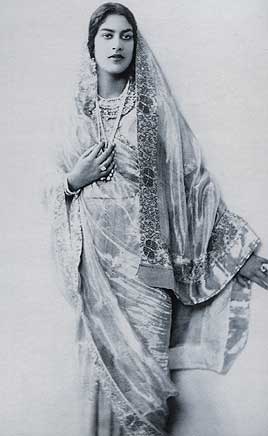
Rani Amrit Kaur Sahib of Mandi was the only daughter of Maharaja Jagatjit Singh by his third wife, Rani Prem Kaur (photo courtesy The Lafayette studio-Russel Harris)
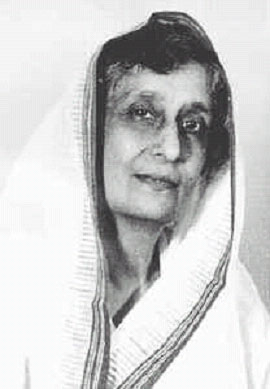
Rajkumari Amrit Kaur (not to be confused with Rani Amrit Kaur) was the daughter of Raja Harnam Singh
She was the first woman to hold a Cabinet rank
serving as Minister of Health from 1947 to 1957 after which she remained a member
of the Rajya Sabha until her death on Feb.2, 1964
Maharaja's
Intimate Friends
Among His Highness' most intimate and esteemed
friends for whom he had always retained feeling of attachment may be mentioned
His late Royal Highness the Duke of Connaught whom he first met in 1885 at the
Rawalpindi Darbar on the visit of the late Amir Abdul Rehman of Afghanistan the
late Lord Hardinge of Penshurt, who besides visiting Kapurthala during his Viceroyalty
came again in 1931 during his short sojourn in India; the Earl and Countess of
Halifax; the late Marquis of Willingdon and Marchioness of Willingdon , and the
Marquis and Marchioness of Linlithgow. Field Marshal Lord Birdwood is one of his
oldest and valued friends and the Veteran General Sir Ian Hamilton has known His
Highness intimately since 1890 when he was present at Kapurthala at his investiture.
In this list may also be included Sir Henery Craik who is a dear old friend of
over 40 years.
The Maharaja had a close friendship with Nizam of Hyderabad,
Maharaja Kashmir, Maharaja Patiala, Maharaja Baroda, Maharaja Gwalior and Maharaja
Mysore.
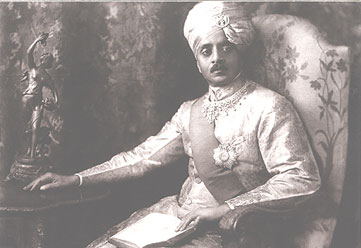
Yuvraj Shri Sir Kanthirava Narasimharaja Wodeyar Bahadur of Mysore (1880-1940) - a close friend of Maharaja Jagatjeet Singh (photo courtesy The Lafayette studio-Russel Harris)
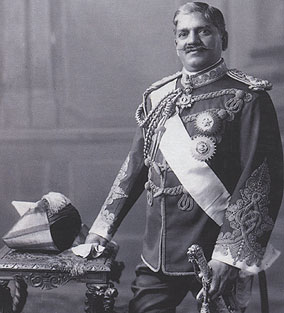
The Maharaja of Baroda (1863-1939) - a close friend of Maharaja Jagatjeet Singh(photo courtesy The Lafayette studio-Russel Harris)
Maharaja
A Popular Host
During the exceptionally long period of 67 years
that the Maharaja had been reigning, Kapurthala had been honoured from time to
time by visits from members of the British Royal Family and others of exalted
rank. His Royal Highness Prince Victor of Wales paid a visit to Kapurthala in
1890, when the Maharaja was a minor. The Marquis of Dufferin and Ava was the first
Viceroy and Governor-General of India to visit Kapurthala in 1886, but from Lord
Hardinge down to the Marquis of Linlithgow, His Highness had rejoiced to welcome
every succeeding Viceroy, all of whom had gladly continued unbroken the chain
of Vice regal visits.
The Maharaja was one of the twelve Ruling Princes of
India whose State was visited by His Royal Highness the Prince of Wales in the
course of his Indian tour in 1921-22. At the State Banquet at Kapurthala the Heir
to the British throne congratulated the Maharaja on the ready help afforded by
the State in the last Great War.
Almost every important Ruling Prince of India
had been received by His Highness in his capital and entertained lavishly. In
many cases this hospitality had been extended to three generations of the same
Ruling House who were all intimate friends of His Highness, to mention specially
Their Highnesses the Maharajas of Kashmir and Patiala. His Highness had been cordially
entertained in their States by the late Nizam and twice by His Exalted Highness
the present Nizam and by the late Maharajas of Baroda, Mysore and Gwalior.
On
the occasion of the Golden Jubilee of his reign in 1927 which was solemnized with
great éclat, in addition to Their Excellencies the Viceroy, the Commander-in-Chief
and the Governor of the Punjab, a galaxy of the most eminent Ruling Princes of
India, over twelve in number, participated in the celebrations at Kapurthala.
The world famous Monsieur Clemenceau "le tigre" visited Kapurthala after
the Great War, and General Gaouraud, Military Governor of Paris, a veteran of
undying fame came to Kapurthala in 1928. King George of Greece who was a personal
friend of the Maharaja visited Kapurthala in 1935 and stayed for a few days.
Maharaja's
War Services
The fidelity of Kapurthala to the British crown is
well known. The present ruler has fully maintained the glorious traditions of
his house in this respect. In 1878-79, on the out break of the Afghan war, the
State troops, comprising 500 infantry, 100 cavalry, three guns and a hundred artillery,
rendered active service on the Bannu frontier under General Watson. The detachment
was highly spoken of by the British officers for its discipline and good conduct.
In 1897 the Maharaja dispatched his imperial service regiment (which was formed
in 1888) for active service in connection with the Tirah Campaign. The regiment
received its baptism of fire and gave an excellent account of it.
A detachment
of 36 rank and file lost its way at Kurman, in the Kurrum Valley and was ambushed
by a relentless enemy, but this small force put up a gallant defense again superior
odds and preferred heroic death to surrender. On this occasion the Government
of India communicated their heart felt regrets and sympathies to his Highness,
who raised near the regimental lines a permanent memorial to the heroism of this
ill-fated but gallant little detachment.
At the outbreak of the Great War
in 1914 His Highness was the first Prince who offered to place all his resources
at the disposal of the British Government. The Kapurthala Imperial Service regiment
was dispatched for active service in East Africa, where it remained for nearly
four years and did excellent work. His Highness himself visited the battlefront
in France in 1915 at the invitation of the late Earl of Birkenhead; His Highness
took part at the official opening ceremony of India's memorial at Neuve Chapelle
in France.
On the successful termination of the Great War the regiment saw
active service in Seistan during the Afghan Campaign, and later on spent six months
performing imperial duties in Mesopotamia.
In the Second World War His Highness
placed his personal services and all the resources of His State the disposal of
the King Emperor. The Kapurthala Battalion was the first among the Indian States
to proceed on active service and took part in actual fighting at Singapore; where
the Japanese along with troops of several other Indian states unfortunately captured
it.
The state had done commendable work as regards recruitment, and had raised
over 3,000 combatants for the Indian army and over 1,800 technical recruits since
the outbreak of the war the state had contributed about Rs. 1,20,000 to the various
war fund, while investments amounting to nearly Rs.21, 25,000 in the defense bonds,
war loan, saving banks, etc. have been made. Special measures had been taken to
render help to the families of soldiers on the front, and to safe guard their
interests by promulgating special regulations. A special staff of Welfare Officers
had been appointed to look after the dependents of absent soldiers and to render
than every assistance.
The Maharaja had been favoured with high honours by
the King Emperor, and was rich in the esteem and affection of a wide circle of
friends in both the hemispheres. He was above all fortunate to had won and retained
all along the profound loyalty and devotion of his subjects. He was venerated
as the father of his people, which owes its present frame and prestige entirely
to his personality and benevolent guidance.
Agriculture & Industry During
Regime
To protect the economic interests of the agriculturists Co-operative
Credit Societies numbering 280 were functioning successfully in the villages of
the State in that time. During his period, An Agricultural Demonstration Farm
had been setup, which supplied seeds of improved varieties to the Zemindars, and
did propaganda work in favour of the scientific methods of cultivation. Work had
also been done on village upliftment and improvement of animal husbandry during
regime of Maharaja.
Particular attention had been devoted to promote Industrial
development, and the State had industries like Sugar Mill at Phagwara & Hamira,
a few miles from Kapurthala. Great industrial expansion had taken place in the
State in those years, and a number of Chemical, Steel and Leather Factories had
come into existence. One of the biggest Distilleries in India was setup at Hamira
in 1944-45.
Architectural Monuments During Regime
The Maharaja Jagatjit
Singh was completely captivated by France, the French Art, the Culture and the
Style of LOUIS XIV. His Agrat Palace and gardens were modeled on Versailles. He
hired a French architect M. Marcel and entitled the project, the 'Elysee Palace'.
Because of exorbitant costs of the building, which started out with red sandstone,
had to be finished off with pink plaster. It costed around Rs. 3,00,000 at that
time. It was built in renaissance style with the sunken park in the front and
has many similarities to that of Palace of Versailles. The construction of Palace
took roughly eight years (1900-1908).
Expert European and Indian workmen carried
out the interior decoration of the Palace, which is unique of its kind in India.
The great Durbar Hall is one of the finest in India and is entirely in the Indian
Style appropriate for the ceremonials, which were performed on important occasions.
The 'Beaux Arts' so popular in 19th century has been performed at various roofs
etc. the center section of Palace was remarkably like a pavilion-end and from
Fontainebleau. The Masard roof (it a roof with double slope, the lower being steeper
than the upper) with its 'Oeil-de-boeuf' windows were copied from te Paris Louvrs
as were the coupled columns lining the blind arcade on the two wings. Lapis Lazuli
painting depicting had been brought from Italy
Among other buildings in the
State, the most notable are the Courts of Justice, the State Gurudwara, The Moorish
Mosque and the magnificent Gurudwara Ber Sahib at Sultanpur. These Buildings are
by common consent striking architectural embellishment of Kapurthala and monuments
to the refined taste and culture of the Ruler.
Social Position During Regime
During
the exceptionally long period of 54 years' reign it had been the Maharaja's earnest
endeavour to so all he could for the advancement of his State and his people.
Particular attention had been devoted to the beneficent departments of the State.
The expenditure on Education, Medical and Public Works Departments had risen gradually
and represents nearly 25 per cent of the gross income of the State proper. The
State maintained more educational institutions and the percentage of boys of school
going age attending these schools was higher than in the adjoining districts.
The expenditure of education alone had risen from Rs.22, 000 in 1890 to over two
lakhs per annum since the year 1925.
Hospitals and dispensaries were founded
in all towns and important centers of the State with the object of affording medical
relief within a radius of four miles. The state could boast of an efficient system
of sanitation, sewerage and drainage at that time.
His Highness had wisely
realized almost 25 years ago that the Indian States could not for long remain
indifferent to the political forces working all round, and the rapidly changing
conceptions of Indian society, and that it was necessary in their own interest
to associate the people more intimately with the administration of the States.
Civil bodies composed of a majority of elected members were functioning in
the municipal towns of the state, and were presided over by non-officials. A Rural
board consisting entirely of elected agriculturists supervises village sanitation,
village roads and controls measures of rural welfare. To afford relief to the
destitute of the state and with a view to reduce professional beggary His highness
has decided to establish a poor house at Kapurthala, where the poor and the needy
will be comfortably lodged and properly looked after. The inmates will be trained
in simple and useful handicrafts that will enable them to earn their livings when
they leave the asylum.
Information courtesy of http://www.kapurthalaonline.com
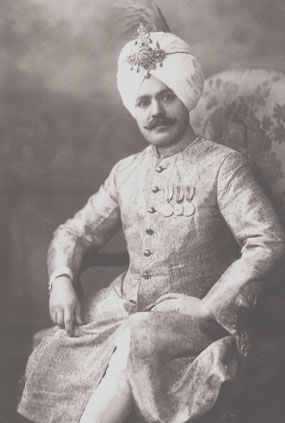
Sirdar Charanjit Singh of Kapurthala (1883-) visited England in 1920 (photo courtesy The Lafayette studio-Russel Harris)
KAPURTHALA (Princely State)
(13 gun salute)
AREA: 1,551 km2 PRIVY
PURSE: 270,000R ANNEXATION: 20th August 1948
STATE: Pepsu DYNASTY: Ahluwalia
RELIGION: Sikh
PRESENT RULER: Brig. HH Maharaja Sri SUKHJIT SINGH Sahib Bahadur, 9th Maharaja of Kapurthala (1955/-)
born October 1934, married
HH Maharani Geeta Devi and has issue, four daughters and one son.
·
Tikka Shatrujit Singh
PREDECESSORS AND SHORT HISTORY:Founded in 1772. Rulers
were....
· Dewa Singh, married and had issue.
· Badar Singh,
married and had issue. He died 1723.
· Sardar JASSA SINGH
·
Sardar Singh, married and had issue.
· Lal Singh, married and had issue.
· Mihr Singh
· Manna Singh
· Gurbaksh Singh,
married and had issue.
· Kirpal Singh, married and had issue.
·
Ladha Singh, married and had issue.
· Sardar BAGH SINGH (see below)
1. Sardar JASSA SINGH 1772/1783 , born 3rd May 1718 at Ahlu or Ahluwal near
Lahore, Sultan-ul-Qaum [cr.1761], leader of the Ahluwalia misl and of the Dal
Khalsa, which in 1758 proclaimed the sovereignty of the Sikhs in the Punjab, married
and had issue. He died 1783.
· Daughter, married Mohan Singh of Fattahabad,
died 1777.
· Daughter, married Mirar Singh of Tungwala.
1. Sardar
BAGH SINGH 1783/1801, born 1748, married and had issue. He died 1801.
·
Sardar FATEH SINGH (qv)
· Daughter, married Ratan Singh of Behra.
1.
Sardar FATEH SINGH 1801/1837, born 1784, succeeded to the Ahluwalia chiefship
in 1801, took part in almost all the early campaigns of Maharaja Ranjit Singh
- Kasur 1802/1803, Malva 1806/1808, Kangra 1809, Multan 1818, Kashmir 1819 and
Mankera 1821. He fought in the battle of Haidru 1813 and held command in the Bhimbar,
Rajauri and Bahawalpur expeditions. In 1806, Fateh Singh acted as the plenipotentiary
of Maharaja Ranjit Singh and signed the first Anglo-Sikh treaty with Lord Lake.
He had bestowed upon him the districts of Dakha, Kot, Jagraoh, Talvandi, Naraingarh
and Raipur after his Malva campaigns, married and had issue. He died October 1837.
· Raja NIHAL SINGH (qv)
· Kanwar Amar Singh, died 28th March
1841 in a boat accident in the Ravi.
1. Raja NIHAL SINGH 1837/1852, received
the towns of Nur Mahal and Kalal Majra, fought on the side of the Sikhs both at
Baddoval and 'Alival and was penalized by the British by the confiscation of his
territories south of the Sutlej, married and had issue. He died 13th September
1852.
· HH Raja-i-Rajgan Raja Sir RANDHIR SINGH Bahadur (see below)
· Kanwar Bikram Singh, born 1835, died 1887.
· Kanwar Suchet
Singh, born 1837, married and had issue. He died 1901.
· Raja Sardar
Charanjit Singh, born 1883, Raja [cr.1932], married and had issue. He died 1970.
· Rajkumar Ajit Singh, born 18th April 1901, educated at Harrow 1915/1918.
· Rajkumar Sarabjit Singh, born 3rd August 1902, educated at Eton.
· Rajkumar Ripjit Singh, born c1907, married Naina Devi (Nilina Sen)
died November 1993 aged 76, grand daughter of Keshub Chandra Sen, and had issue.
He died 1949.
· Nilika Ripjitsingh
· Kanwar Karanjit Singh
· Reena Ripjitsingh
· Kanwar Ratanjit Singh, married Pronoti
Devi, daughter of Sailen Prasad Barooah, an aristrocrat from the foremost and
renowned family of Assam (Jorhat).
1. HH Raja-i-Rajgan Raja Sir RANDHIR SINGH
Bahadur 1852/1870, G.C.S.I., born March 1831, married 1stly Rani ......, died
1853, 2ndly Rani ....., died 1857 and had issue. He died 2nd April 1870.
·
HH Raja-i-Rajgan KHARAK SINGH
· Hon. Raja Sir Harnam Singh , born 15th
November 1851, K.C.I.E. [cr.1899], C.I.E. [cr.1885], Raja [cr.1907], managed Kapurthala
Estates in Oudh for 18 years, Member of Council of Governor-General of India and
of Legislative Council of Punjab, Member of the Hemp Drugs Commission 1893/94,
Honorary Life Secretary of the British India Association of Taluqdars of Oudh,
Fellow of Punjab University, Member of Council of State for India, married 1875
Kanwar Rani Sahiba and had issue.
· Raja Sir Maharaj Singh , born 17th
May 1878, C.I.E. [cr.1915], Kt. [cr.1933], educated at Harrow 1891/1896 and at
Balliol College, Oxford (B.A. 1900, M.A. 1910), Bar Middle Temple 1902, appointed
Deputy Collector, United Provinces, India 1904, Assistant Registrar, Co-operative
Credit Societies 1908 (Officiating Registrar 1909/10), Assistant Secretary, Department
of Education 1911, Senior Assistant Secretary 1915, Magistrate and Collector 1917,
Secretary to Government of United Provinces 1919, Deputy Secretary to Government
of India 1920, Deputy Commissioner United Provinces 1923, Chief Minister of Jodhpur
State 1931, Agent to Government of India in South Africa 1932, Member of the Executive
Council in UP 1935/1937; married February 1918, Rani Gunwati Maya Das and had
issue. He died 6th June 1959 in Lucknow.
· Raja Ranbir Singh, born
11th June 1919, educated at Bishops School in South Africa and Balliol College,
Oxford. A diplomat for the Indian government serving as a Charge D'Affaires in
Tokyo, Cairo, The Hague and Dublin, married and had issue. He died June 1996 in
New Delhi.
· Raja Jai Singh, educated at Harrow School, living in Florida,
USA .
· Rajkumar Pratap Singh, educated at Harrow School, living in
Bath, England, married and has issue, 1 son and 1 daughter.
· Rajkumari
Prem Kaur, living in Lucknow, India, married and has issue
· Arun Seth
· Arati Seth
· Rajkumar Mahinder Singh, living in Chandighar,
Punjab, India, married and has issue.
· Pria Kaur
· Kunwar
Jasbir Singh
· Kunwar Raghbir Singh, educated at Harrow 1890/1894.
· Rajkumari Amrit Kaur, born 2nd February 1889 in Lucknow, educated
in England, Member of the Lok Sabha 1952/1957, Union Minister of Health 1947/1957,
Union Minister of Health and Communications 1951/1952, Member of the Rajya Sabha
1957/1964, Secretary to Mahatma Gandhi for 16 years; President of the World Health
Assembly 1950 and the International Red Cross Conference, New Delhi 1957; Founder-Member
and Chairman, Managing Body of Indian Red Cross Society, died unmarried, 10th
February 1964.
· Daughter, born 1850.
· SON (by 2nd wife),
died aged 2 months.
6. HH Raja-i-Rajgan KHARAK SINGH 1870/1877, born August
1849, married and had issue. He died 5th September 1877.
7. Col. HH Farzand
i-Dilband Rasikhul-Itiqad Daulat-i-Inglishia Raja-i-Rajgan Maharaja Sir JAGATJIT
SINGH Bahadur 1877/1949, born 24th November 1872, assumed full ruling powers in
November 1890, K.C.S.I. [cr.1897], G.C.S.I. [cr.1911], G.C.I.E. [cr.1921], G.B.E.,
Maharaja [cr.1911], Hon. Colonel 3/11th Sikhs, has Grand Cross of Legion of Honour
of France, Grand Cordon of of Order of the Nile, and Grand Cross of Orders of
Cuba, Chile, Peru and Morocco, Representative of League of Nations Assembly 1926,
1927 and 1929, appointed Up-Rajpramukh of PEPSU, married 1stly 16th April 1886
HH Maharani Harbans Kaur , daughter of Mian Ranjit Singh Gularia of Poprola, married
2ndly 1910 (div), Anita Delgrado, born Malaga, Spain, married 3rdly, Evgenia Grosupova,
daughter of a Czech Count and Nina Grosupova, an actress, commited suicide by
jumping off the Qutub Minar in Delhi, and had issue. He died 19th June 1949.
·
HH Maharaja PARAMJIT SINGH
· Maharajkumar Mahajit Singh, died 1932
· Maharajkumar Amarjit Singh, born 5th August 1893, married Maharajkumari
Sonia died 4th July 1947. He died September 1944 in Srinagar.
· Maharajkumar
Maramjit Singh, married with issue.
· Kunwar Shri Arun Singh, born
29th August 1944, B.A. (Hons.), M.A. (Cantab), Member of the Rajya Sabha 1984/1988,
Parliamentary Secretary to the Prime Minister 1984/1985, Union Minister of State,
Department of Defence Research and Development, 1985/1987; married Shrimati Kunwarani
Nina Singh and has issue, 2 sons and 1 daughter. (St. Helen's Cottage, Mussoorie,
Uttar Pradesh, India)
· Maharajkumar Karamjit Singh, educated at Harrow
1910/1913.
· Maharajkumar Aji Singh (by Anita), born 1910, died 7th
June 1967.
· Rani Amrit Kaur married 1923 Maj. HH Raja Sir JOGINDER
SEN Bahadur of Mandi.
8. HH Maharaja PARAMJIT SINGH 1949/1955, educated at
Harrow 1906/1907, born 18th May 1892, married 1stly HH Maharani Brinda Mathi of
Jubbal, 2ndly Stella Mudge died 1984, 3rdly (.... , died aged 21), and had issue.
He died 1955.
· Brig. HH Maharaja Sri SUKHJIT SINGH Sahib Bahadur (by
third wife)
· Maharajkumari Indira Kaur, died unmarried in Chelsea,
London.
· Maharajkumari Sushila Devi, married Raja Giriraj Saran Singh
of Bharatpur.
· Maharajkumari Urmila Devi, married Rajkumar Birendra
Singh of Jubbal.
9. Brig. HH Maharaja Sri SUKHJIT SINGH Sahib Bahadur
Some information has been taken with courtesy and thanks from http://www.4dw.net/royalark/India/kapurth.htm
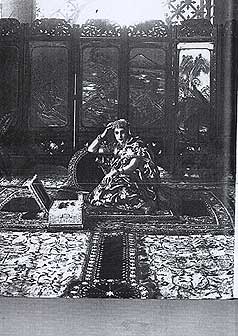
Spanish wife of Maharaja Jagatjit Singh
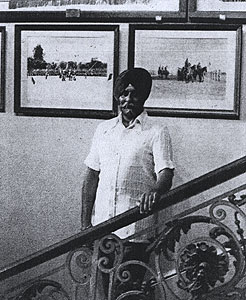
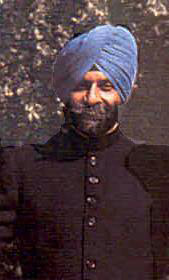
Brigadier Sukhjit Singh, Maharaja of Kapurthala, now retired from the Indian Army to concentrate on farming in Kapurthala. His grandfather's Jagatjit Palace is now a military academy for boys.
We proudly present the family of Kanwar Bikrama Singh, the second son of Raja Nihal Singh. The details and photos have been kindly supplied by Kanwar Vishvjit Singh of Kapurthala, Former Member of Parliament, India. Our sincere thanks to him for bringing to our notice few discrepencies in the above article and furthermore supplying us with details of his family. (Kanwal)
Kanwar Bikrama
Singh Bahadur, CSI (29.7.1879). b. at Kapurthala Fort, 1835, educ. privately.
Served during the Indian Mutiny, commanding a Kapurthala contingent (rcvd: Mutiny
medal). Attended the Imperial Durbar, Delhi, 1877 (rcvd: KIH medal). Granted the
title of Sardar Bahadur, 2nd June 1858. Hon. Magistrate and Hon. Assist. Commissioner
for Jullunder District. 1879, President. Jullunder Municipal Board. Well versed
in English, Persian, Sanskrit, and Punjabi, an Oriental Scholar and Master of
Indian Classical Music, a very eminent Musicologist, he was also a great proponent
of Western learning and of women's education. Author of "Upma Sar Granth".
Founder of the Singh Sabha, the 19th Century Sikh Religious Organisation committed
to the Reform of the Gurudwaras which is still active all over India. Founder
Khalsa Press. Lahore. Founder Khalsa Akhbar. m. 16th February 1849. He died at
Jullunder, 8th May 1887, having had issue, two sons and two daughters:
1st
son of Bikrama Singh:
Colonel Kanwar Partap Singh Bahadur, KCSI (posth. 12.12.1911,
CSI 1.1.1909). b. at Jullunder, 1871, educ. privately. Hon. Magistrate and Civil
Judge Punjab, Hon. ADC to the Maharaja of Kapurthala 1893, MLC Punjab 1906-1911,
Member. Imperial Legislative Council. 1910-1911. Founder Punjab Chiefs Association.
Delhi Durbar Silver Medal (1903). He d. 5th December 1911, having had issue, two
sons:
1st son of Pratap Singh:
Major Kanwar Jasjit Singh. b. 12th April
1893 at Jullunder, educ. Aitchison Coll., Lahore. Hon. Magistrate for Jullunder
Dist. 1915-1943, Cmsnd. Hon. 2nd-Lieut, ILF 1/2/1918 attached 6th Duke of Connaught's
Own Lancers, served in Afghanistan and NWF 1919 (rcvd: Waziristan medal), prom.
Hon. Lieut. 1/2/1919, prom. Hon Capt. 1/2/1923, Hon. Maj. 1/2/1936, Vice-Chair.
Jullunder District Brd. Rcvd: Delhi Durbar Silver Medal (1911), Silver Jubilee
(1935), and Coron. (1937) medals. Married 1.) daughter of the Hon. Rai Bahadur
Buta Singh of Rawalpindi C.I.E. O.B.E Married 2) daughter of Sardar Hukam Singh,
the Jagirdar of Butari in Ludhiana District . He d. 29th March 1943, having had
issue, three sons and one daughter:
1st son of Jasjit Singh:
Captain Kanwar
Prithvijit Singh. b. 11th May 1912 at Jullunder educ. Aitchison Coll., Lahore.
Col Browns School, Dehra Dun. Royal Military College Sandhurst. Cmsnd as a 2nd-Lieut,
IA (KCIO) 1/9/1932, attached 1st Btn, 7th Rajput Regt. 5/3/1934, D.20.8.1942 at
Lucknow. Married 1936 Bibi Surjit Kaur (Bibi Surjit Kaur died at Chandigarh 24.4.1966)
daughter of Sardar Dwarka Nath Singh Minister, Kapurthala State (he died in 1918)
Sardarni Vidya Wati Dwarka Nath Singh Bahadur (personal title granted to her in
the 1920's) She (Bibi Surjit Kaur) adopted one son:
Son of Prithvijit Singh:
Kanwar
Shri Vishvjit Prithvijit Singh. (son of Kanwar Ranjit Singh - see below) born
29th October 1946 Jullunder educ. Doon School Dehra Dun. Member of Parliament,
India (Rajya Sabha) 1982 to 1988 and 1988 to 1994. m. 8.5.89 Kumari Vijay Thakur.
(Kanwarani Vijay Thakur Singh) Diplomat -m Indian Foreign Service (b. at Simla,
18th September 1960), educ. Tara Hall Convent and Himachal Univ., Simla (M.Econ.
& Law), joined Indian Foreign Service and served at Madrid, , Dir. Pakistan
Dvsn. at the Ministry of External Affairs in New Delhi, Counsellor Permanent Mission
to the UN New York, Dep. chief of Mission at Kabul, daughter of The Hon. Justice
Thakur Hira Singh of the High Court of Himachal Pradesh, by his wife, Mrs. Nirmal
Thakur.
2nd son of Jasjit Singh:
Kanwar Manjit Singh. b. 1918 at Jullunder
educ. Scindia Sardar's School Gwalior. Hon. Lieut. ILF, 18/12/1945. d. 1962 at
Jullunder Married Kanwarani Veena Manjit Singh had 2 sons:
1st son of Manjit
Singh:
Kanwar Chandrajit Singh b.25.12.1946 Jullunder Entrepreneur.
2nd
son of Manjit Singh
Kanwar Aniljit Singh b.15.8.1950 at Jalandhar. Edu Modern
School Jalandhar, Bsc Queen Mary College London. Msc Imperial College London.
Msc Berkbeck College London Computer Scientist. Entrepreneur. Married 7.11.85
at London, Padma (Kanwarani Padma Aniljit Singh) daughter of Mr. Balram Bisram
(Civil Servant UK) He has one son
Son of Aniljit Singh:
Kanwar Amarjit
Singh. b.14.6.1989 at London being educated at Charterhouse School UK
3rd
son of Jasjit Singh:
Kanwar Ranjit Singh . b. 1922 Jullunder. Volunteer with
the Red Cross. educ. Scindia Sardar's School Gwalior. m. Anjna Devi daughter of
Sardar Rachhpal Singh (she died ).1953 had one son:
Son of Ranjit Singh:
Kanwar
Shri Vishvjit Singh (adopted by Kanwarani Surjit Kaur widow of Kanwar Prithvijit
Singh - see above) born 29th October 1946 Jullunder educ. Doon School Dehra Dun.
Member of Parliament, India (Rajya Sabha) 1982 to 1988 and 1988 to 1994. m. 8.5.89
Kumari Vijay Thakur. (Kanwarani Vijay Thakur Singh) Diplomat -m Indian Foreign
Service (b. at Simla, 18th September 1960), educ. Tara Hall Convent and Himachal
Univ., Simla (M.Econ. & Law), joined Indian Foreign Service and served at
Madrid, , Dir. Pakistan Dvsn. at the Ministry of External Affairs in New Delhi,
Counsellor Permanent Mission to the UN New York, Dep. chief of Mission at Kabul,
daughter of The Hon. Justice Thakur Hira Singh of the High Court of Himachal Pradesh,
by his wife, Mrs. Nirmal Thakur.
Daughter of Jasjit Singh:
Kumari Uma
Devi b.at Jullunder m. Lieutenant-General Daulat Singh IA (KCIO) (b. at Indore,
4th January 1911) d. in an aeroplane crash at Poonch, 22nd November 1963), son
of Colonel Wazir ud-Daula, Rai Bahadur Dina Nath, CIE, sometime Chief Minister
of Indore State. She had issue, three sons and one daughter:
1st son of Uma
Devi:
Jitendra Daulet Singh. Diplomat. (Indian Foreign Service). Edu Mayo College
Ajmer. Cambridge UK. Former Indian Ambassador to Norway. m. Renuka daughter of
Brigadier Shiv Dayal Singh IA. He has 2 issues, one son and one daughter:
Son of Jitendra Daulet Singh:
Jaywant Daulet Singh b.1.9.1976. edu Mayo College
Ajmer. Durham University UK. Financial Consultant.
Daughter of Jitendra Daulet
Singh
Devika Daulet Singh. B.29.5.1972. edu St Stephens College Delhi, Rhode
Island School of Design USA Photographer. Photo Archivist and Editor. (Photoink)
2nd son of Uma Devi:
Surendra Daulat-Singh, b. 4.6.1942. edu Mayo College Ajmer.
BA (Hons in History) St Stephens College Delhi. Former Banker. (BBME, Grindlays
etc} CEO Executive Search (GKR. Daulat-Singh) m. 6.10.1967 Purnima Bawa daughter
of Late Bawa Gyan Singh of Lahore. They have 3 issues, one son and 2 daughters:
Son of Surendra Daulat-Singh:
Karamendra Daulat-Singh m. Gayatri Ghai daughter
of Mr Ravi Ghai. Edu at Cathedral School Bombay, Law Degree from Cambridge UK.
Corporate Lawyer. (Daulat-Singh and Associates) They have one son and one daughter:
Son
of Karamendra Daulat-Singh:
Amar
Daughter of Karamendra Daulat-Singh
Rhea
1st
daughter of Surendra Daulat-Singh:
Nanaki. b.1971. edu Cathedral School Bombay,
St Xaviers College Bombay. m. Nikhil Arora.(Entrepreneur) They have 2 daughters:
1st daughter of Nanaki:
Tara
2nd daughter of Nanaki:
Alekha
2nd daughter
of Surendra Daulat-Singh:
Basanti m. Anuj Didwania (Entrepreneur) They have
one daughter:
Daughter of Basanti:
Puja
3rd son of Uma Devi:
Vijayendra
Daulet Singh. B. 13.6.1946 at Delhi. Edu Mayo College Ajmer, St Stephens College
Delhi. Entrepreneur. Chairman. Institute of Technology and Management, Gurgaon
(www.itmindia.com) m.16.4.1976 Hareena daughter of Late Col. Gurbaksh Singh. Indian
Army (Artillery). They have three issues, 2 sons and one daughter:
1st son
of Vijayendra Daulet Singh:
Zorawar Daulet Singh b.21.12.1978 at Delhi. Edu
The British School Delhi. University of London UK. Presently studying at John
Hopkins University Washington USA
Daughter of Vijayendra Daulet Singh:
Mekhala
b.10.3.1981 at Kanpur. Edu Modern School, New Delhi. College of Art Delhi. Rhode
Island School of Design Providence USA. m. 21.3.2004 Aman Behl son of Mr Navin
Behl. Artist.
2nd son of Vijayendra Daulet Singh:
Bikrama Daulet Singh.
B. 14.11.1982. edu The British School, New delhi. London School of economics UK
Consultant with Accenture
Daughter of Uma Devi:
Chandrika Devi (Chandrika
Mehra) b. 19.2.1939 at Indore. Edu Maharani Gayatri Devi Girls Public School Jaipur.
Lady Irwin College New Delhi. m. 13.12.1958 Ganesh Saran Mehra son of Rai Bahadur
Ganga Saran, Banker (Grindlays Bank) 3 sons and one daughter.
1st son of Chandrika
Mehra:
Sanjay Saran Mehra. b.16.12.1959. edu Bishop Cotton School Simla. Sriram
College of Commerce Delhi. Banker.
2nd son of Chandrika Mehra:
Shiv Saran
Mehra b.29.4.1963. edu Bishop Cotton School Simla, Delhi University. Edupreneur.
Member of the governing Body of the Institute of technology and Management Gurgaon.
m.18.2.1989 Nitya daughter of Col Shyam Rattan Indian Army (Regiment of Guards)
Daughter
of Shiv Saran:
Anuja b.16.1.1992
3rd son of Chandrika Devi:
Siddharth
Saran Mehra b.31.10.1964. edu Bishop Cotton School Simla. Delhi University. Boston
University USA/ Entrepreneur. m. Sharmila daughter of Late D.R.Tandon of Delhi
Son
of Siddharth Mehra:
Rohan b.1.2.2005
Daughter of Chandrika Mehra:
Radhika
Mehra b.4.4.1968. edu Delhi Public School New Delhi. Entrepreneur.
2nd son
of Pratap Singh
Kanwar Madanjit Singh. b. 1898 at Jullunder He died 1930 at
Jullunder m. Parbati (she died at Jullunder )
2nd son of Bikrama Singh
The
Hon. Raja Sir Daljit Singh, KBE (c 3.6.1919), CSI (22.6.1911). b. at Kapurthala,
7th December 1882, educ. Aitchison Coll., Lahore. Hon Magistrate for Jullunder
Dist., MLC Punjab 1913-1915, Mbr of the Imperial Legislative Cncl. at Calcutta
1913-1915, Mbr. Cncl. of State 1915-1917, Chief Minister of Jammu and Kashmir
State 1917-1921. Rcvd: Delhi Durbar silver medal (1911). m. Rani Jasbir Kaur [Lady
Daljit Singh] (b. at Hansa, Ludhiana, September 1886; d. December 1938), daughter
of Sardar Hardit Singh, of Hansa, Ludhiana dist., Punjab. He d. 6th November 1946,
having had issue, two sons:
1st son of Daljit Singh:
Rajkumar Atamjit Singh.
b. 1900 Jullunder educ. Aitchison Coll., Lahore. Cmsnd. as 2nd-Lieut. IA (KCIO)1925.
He d. 1925 at Jullunder having had issue, an only son:
Son of Atamjit Singh:
Kanwar
Satyajit Singh. b. at Jullunder, Punjab, 28th December 1922, educ. Bishop Cotton
School. Simla, and St Stephen's College Delhi. Farmer. Amateur Shakespearean Actor.
m. Kumari Kamini Devi (Kanwarani Kamini Satyajit Singh) (b. 12th April 1928; d.
6th October 1999), daughter of Ishwar Das Mahendru, of Multan, sometime Punjab
Forest Service. He died at Lucknow, 22nd November 1980, having had issue, one
son and one daughter:
Son of Satyajit Singh:
Kanwar Mukuljit Singh. b.
6th October 1961, edu Colvin Taluqdars' College., Lucknow, and Lucknow University.
Entrepreneur. Sportsman (Rifle Shooting Champion) Conservationist. Secretary The
Tiger Haven Society. m. 19th October 1996, Kumari Pragya Devi, (Kanwarani Pragya
Singh) daughter of Colonel Ranbir Singh Chouhan, 18 Jat Regt., IA. He has issue,
one son:
Son of Mukuljit Singh:
Kanwar Samarjit Singh. b. 1997, being educated
at Lucknow.
Daughter of Satyajit Singh:
Kumari Bani Kaur. b. 14th September
1965 at Sitapur m. 29th November 1987 at New Delhi Harjit Singh Ahuja born 17.10.1962
at Delhi CEO Forbes Mumbai, son of Brigadier Gurdial Singh Ahuja, Corps of Engineers,
IA. She has issue, two daughters:
1st daughter of Bani Kaur:
Anahita Kaur
Ahuja. b. 18.11.1989.
2nd daughter of Bani Kaur
Anandita Kaur Ahuja. b.
25.6.1991.
2nd son of Daljit Singh
Raja Padamjit Singh. b. 1909 -. Bishop
Cotton Sch., Simla, and Aitchison Coll., Lahore. m. Padma [Kunwarani Padamjit
Singh] - daughter of S.B.Sardar Bahadur Sardar Kishan Singh, Rais of Fatehabad
Rais of Fatehabad Retired as Inspector General of Police) Scholar of comparative
Religion, Philosophy and Indian Classical Music. He d. 9th January 1971 died at
New Delhi having had issue, three daughters:
1st daughter of Padamjit Singh:
Rajkumari
Bibi Lalita Kumari. b.1932 edu Convent of Jesus and Mary Simla, St Bedes College
Simla. m. Lt General Inderjit Khanna. Indian Army (4th Guards) 2 daughters:
1st daughter of Lalita Kumari
Kumari ILIKA Nandini b.1961 m. Sardar Jagdeep
Singh Mann son of Sardar Charanjiv Singh Mann of Kot Shera.
2nd daughter of
Lalita Kumari
Kumari Shailaja Nandini. b. 1964. Entrepreneur.
2nd daughter
of Padamjit Singh:
Rajkumari Bibi Anita Singh b.1939 edu Convent of Jesus and
Mary Simla, St Bedes College Simla. Founder Indian Music Society. Advisor Culture
and Heritage, Govt of Punjab. Member Governing Council, Punjabi Academy, Govt
of Delhi, Member Governing Council, National Media Centre, Member Governing Council,
Punjab Sangeet Natak Academy, Member governing Council, Hamdard Foundation. Member
Kapurthala Heritage Trust. has issue one daughter:
Daughter of Anita Singh:
Kumari
Haripriya b.27.8.1964 m.Sardar Govind Singh Mann son of Sardar Brijendra Pal Singh
Mann of Manawala. Agriculturist. 3 sons:
1st son of Haripriya:
Gopal Singh
2nd son of Haripriya:
Anant Singh
3rd son opf Haripriya:
Varad Singh
3rd daughter of Padamjit Singh
Rajkumari Bibi Rama Singh.b. 1941 edu Convent
of Jesus and Mary Simla, St Bedes College Simla. m. (Late) Mohinder Puri President
Punjab, Haryana & Delhi Chamber of Commerce & Industry. President Mohindar
Puri & Co. one son:
Son of Rama Singh:
Ambuj Puri b.1980 d.1992 at Simla.
1st
daughter of Bikrama Singh:
Bibi Saheba Elder m. S. Amar Singh of Patiala Had
4 daughters
2nd daughter of Bikrama Singh:
Bibi Saheba Younger m. S.Devinder
Singh of Gurdaspur. Had 2 sons and one daughter:
1st son of Bibi Saheba Younger:
S.
Brijnandan Singh
2nd son of Bibi Saheba Younger:
S. Prithinandan Singh Retired
as Inspector General of Police Kashmir.
Daughter of Bibi Saheba Younger:
Bibi
Sukhnandan Kaur m. Dr P.C.Hoon of the Doon School Dehra Dun. She had one daughter
and three sons
1st son of Bibi Sukhnandan Kaur:
Brigadier Pran Nath Hoon
Indan Army d. m. Manorama daughter of Sardar Shehdev Singh of Kapurthala. One
son two daughters
1st daughter of Pran Nath:
Tani m.Vir Vashisht. (Entrepreneur)
2nd
daughter of Pran Nath:
Bani.
Son of Pran Nath
Jitendra Singh Hoon edu
Mayo College Ajmer, St Stephens College New Delhi.
Daughter of Bibi Sukhnandan
Kaur:
Sunita m.Brig Chander Bhan. Indian army.
2nd son of Bibi Sukhnandan
Kaur:
Prem Nath expired
3rd son of Bibi Sukhnandan Kaur:
Lt General
Hari Nath Hoon. Indian Army
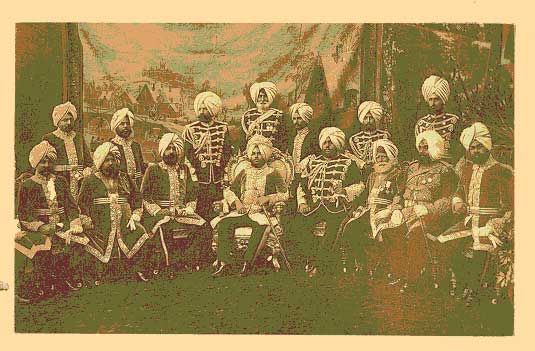
Maharaja Jagatjit Singh with his courtiers.